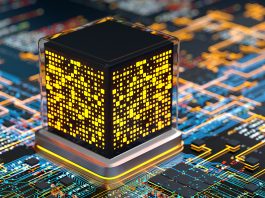Researchers at Penn State have pioneered a cutting-edge topological superconductor that enhances quantum computer stability – a major limitation of the technology.
The team has innovated a novel method to amalgamate two materials – a monolayer superconductor and a topological insulator – with special electrical properties. The combination provides an optimal platform to investigate an unusual type of superconductivity known as topological superconductivity, which could pave the way for topological quantum computers that are significantly more stable than conventional technology.
The team’s research, titled ‘Crossover from Ising- to Rashba-type superconductivity in epitaxial Bi2Se3/monolayer NbSe2 heterostructures’, is published in Nature Materials.
Developing a topological superconductor
Superconductors are utilised in various technologies, including powerful magnets, digital circuits, and imaging. They allow the electrical current to pass without resistance. Contrastingly, topological insulators are thin films only a few atoms thick that restrict the movement of electrons, resulting in unique properties. Penn State researchers have now developed a way to pair the two materials.
Cui-Zu Chang, an Associate Professor of Physics at Penn State and leader of the research team, commented: “The future of quantum computing depends on a kind of material that we call a topological superconductor, which can be formed by combining a topological insulator with a superconductor, but the actual process of combining these two materials is challenging.
“In this study, we used a technique called molecular beam epitaxy to synthesise both topological insulator and superconductor films and create a two-dimensional heterostructure that is an excellent platform to explore the phenomenon of topological superconductivity.”
Prior attempts to merge the two materials yielded poor results, as the superconductivity in thin films usually disappears after the topological insulator layer is grown on top. Experts have been able to apply a topological insulator film onto a three-dimensional ‘bulk’ superconductor and retain the properties of both materials. However, the applications for topological superconductors, such as chips with low power consumption for smartphones and quantum computers, would need to be two-dimensional.
The researchers overcame these issues to innovate a two-dimensional topological superconductor by stacking a topological insulator film made of bismuth selenide (Bi2Se3) with different thicknesses on a superconductor film comprised of monolayer niobium diselenide (NbSe2). The team successfully retained the topological and superconducting properties by synthesising the heterostructures at a very lower temperature.
Hemian Yi, a postdoctoral scholar in the Chang Research Group at Penn State and the first author of the paper, explained: “In superconductors, electrons form ‘Cooper pairs’ and can flow with zero resistance, but a strong magnetic field can break those pairs.
“The monolayer superconductor film we used is known for its ‘Ising-type superconductivity,’ which means that the Cooper pairs are very robust against the in-plane magnetic fields. We would also expect the topological superconducting phase formed in our heterostructures to be robust in this way.”
Solving quantum computer stability issues
The researchers discovered that by tweaking the topological layer’s thickness, the heterostructure shifted from Ising-type superconductivity (where the electron spin is perpendicular to the film) to Rashba-type superconductivity (where the electron spin is parallel to the film). They also observe this phenomenon in their theoretical calculations and simulations.
This heterostructure may be an ideal platform for exploring Majorana fermions – an enigmatic particle that would help to develop a topological quantum computer more stable than previous versions of the technology.
Change concluded: “This is an excellent platform for the exploration of topological superconductors, and we are hopeful that we will find evidence of topological superconductivity in our continuing work. Once we have solid evidence of topological superconductivity and demonstrate Majorana physics, then this type of system could be adapted for quantum computing and other applications.”









